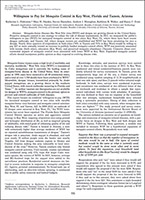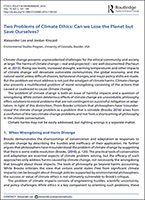CENTER Publications
Below is a sample of recent publications by CSTPR faculty (Center personnel highlighted with multiple authors):
 Public Information and Regulatory Processes: What the Public Knows and Regulators Decide Public Information and Regulatory Processes: What the Public Knows and Regulators Decide
by D.A Crow, E. A. Albright, and E. Koebele (2016)
Review of Policy Research, Vol. 33, No. 1, pp. 90-109
Abstract: Because bureaucratic agencies may be less transparent in their decision processes than legislatures, most states have developed processes to incorporate input from regulated communities and other parties potentially affected by regulations. Administrative agencies may encourage democratic practices to increase legitimacy and accountability of the bureaucracy and improve decision-making processes. However, rules governing the regulatory process vary by state, with some incorporating more open practices than others. Understanding these dynamics is increasingly important, as the rulemaking process has become central to policymaking over the past several decades, with a large portion of policymaking authority delegated to administrative agencies. Drawing from regulatory documents, rulemaking comments, media coverage, and interviews with regulators in 14 regulatory decision processes across five states, this study finds that while states vary in their approach to providing access to information, there are overriding patterns that reduce the role of citizens and the overall transparency of regulatory processes. Read more ... |
| |
 Willingness to Pay for Mosquito Control in Key West, Florida and Tucson, Arizona Willingness to Pay for Mosquito Control in Key West, Florida and Tucson, Arizona
by K.L. Dickinson, M.H. Hayden, S. Haenchen, A.J. Monaghan, K.R. Walker and K.C. Ernst (2016)
American Journal of Tropical Medicine and Hygiene, Vol. 94, No. 4, pp. 775-779
Abstract: Mosquito-borne illnesses like West Nile virus (WNV) and dengue are growing threats to the United States. Proactive mosquito control is one strategy to reduce the risk of disease transmission. In 2012, we measured the public’s willingness to pay (WTP) for increased mosquito control in two cities: Key West, FL, where there have been recent dengue outbreaks, and Tucson, AZ, where dengue vectors are established and WNV has been circulating for over a decade. Nearly three quarters of respondents in both cities (74% in Tucson and 73% in Key West) would be willing to pay $25 or more annually toward an increase in publicly funded mosquito control efforts. WTP was positively associated with income (both cities), education (Key West), and perceived mosquito abundance (Tucson). Concerns about environmental impacts of mosquito control were associated with lower WTP in Key West. Expanded mosquito control efforts should incorporate public opinion as they respond to evolving disease risks. Read more ... |
| |
 Managing Carbon on Federal Public Lands: Opportunities and Challenges in Southwestern Colorado Managing Carbon on Federal Public Lands: Opportunities and Challenges in Southwestern Colorado
by L. Dilling, K. C. Kelsey, D.P. Fernandez, Y.D. Huang, J.B. Milford and J.C. Neff (2016), Environmental Management
Abstract: Federal lands in the United States have been identified as important areas where forests could be managed to enhance carbon storage and help mitigate climate change. However, there has been little work examining the context for decision making for carbon in a multiple-use public land environment, and how science can support decision making. This case study of the San Juan National Forest and the Bureau of Land Management Tres Rios Field Office in southwestern Colorado examines whether land managers in these offices have adequate tools, information, and management flexibility to practice effective carbon stewardship. To understand how carbon was distributed on the management landscape we added a newly developed carbon map for the SJNF–TRFO area based on Landsat TM texture information (Kelsey and Neff in Remote Sens 6:6407–6422. doi:10.3390/rs6076407, 2014). We estimate that only about 22% of the aboveground carbon in the SJNF–TRFO is in areas designated for active management, whereas about 38% is in areas with limited management opportunities, and 29% is in areas where natural processes should dominate. To project the effects of forest management actions on carbon storage, staff of the SJNF are expected to use the Forest Vegetation Simulator (FVS) and extensions. While identifying FVS as the best tool generally available for this purpose, the users and developers we interviewed highlighted the limitations of applying an empirically based model over long time horizons. Future research to improve information on carbon storage should focus on locations and types of vegetation where carbon management is feasible and aligns with other management priorities. Read more ... |
| |
 The Role of U.S. States in Facilitating Effective Water Governance Under Stress and Change The Role of U.S. States in Facilitating Effective Water Governance Under Stress and Change
by C. Kirchhoff and L. Dilling (2016)
Water Resources Research
Abstract: Worldwide water governance failures undermine effective water management under uncertainty and change. Overcoming these failures requires employing more adaptive, resilient water management approaches; yet, while scholars have advance theory of what adaptive, resilient approaches should be, there is little empirical evidence to support those normative propositions. To fill this gap, we reviewed the literature to derive theorized characteristics of adaptive, resilient water governance including knowledge generation and use, participation, clear rules for water use, and incorporating nonstationarity. Then, using interviews and documentary analysis focused on five U.S. states’ allocation and planning approaches, we examined empirically if embodying these characteristics made states more (or less) adaptive and resilient in practice. We found that adaptive, resilient water governance requires not just possessing these characteristics but combining and building on them. That is, adaptive, resilient water governance requires well-funded, transparent knowledge systems combined with broad, multilevel participatory processes that support learning, strong institutional arrangements that establish authorities and rules and that allow flexibility as conditions change, and resources for integrated planning and allocation. We also found that difficulty incorporating climate change or altering existing water governance paradigms and inadequate funding of water programs undermine adaptive, resilient governance. Read more ...
|
| |
 Two Problems of Climate Ethics: Can we Lose the Planet but Save Ourselves? Two Problems of Climate Ethics: Can we Lose the Planet but Save Ourselves?
by A. Lee and J. Kincaid (2016)
Ethics, Policy & Environment
Excerpt: Climate change presents unprecedented challenges for the ethical community and society at large. The harms of climate change—real and projected—are well documented (Pachauri et. al, 2015). Rising sea levels, increased drought, warming temperatures and other impacts of climate change will devastate vulnerable communities, the global economy, and the natural world unless difficult choices, behavioral changes, and major policy shifts are made. But the problem we must address is not just the amalgam of climate harms. Climate change also presents a multifaceted problem of moral wrongdoing consisting of the actions that caused or coalesced to cause climate change. The ‘problem’ of climate change is both an issue of harmful impacts and a question of wrongdoing. While certain deleterious effects of climate change are unavoidable, philosophy offers solutions to moral problems that are not contingent on successful mitigation or adaptation. In light of this distinction, Thom Brooks’ criticism that philosophers have ‘misunderstood’ the climate change problem as a problem that is solvable (Brooks, forthcoming) arises from a conflation of the two climate change problems and not from a shortcoming of philosophy in the climate conversation. Climate harms may not be easily addressed, but righting wrongs is a separate matter. Read more ... |







